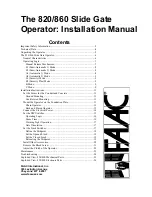
11
Installation Instructions
Note
: The following installation instructions
assume you are fully capable of installing an
electronic operator for a gate. This manual does not
instruct you in designing a gate, installing a gate
(whether on masonry, wood, or metal posts), or
basic electrical wiring. The installation tasks
discussed in this manual are tasks peculiar to the
820/860 Operator.
Before you install the 820 or 860 Operator, you must
insure that the gate leaf falls within the limitations
outlined in the section "Technical Data." Installing the
820 or 860 Slide Gate Operator consists of the
following steps:
•
Setting the forms for the conduit and concrete
•
Mounting the operator on the foundation plate
•
Connecting electrical power
•
Setting DIP switches
•
Setting the limit switches
•
Installing other accessories
•
Removing the bleed screw
•
Adjusting the clutch of the operator
Set the Forms for the
Conduit and Concrete
Ground Mounting
You need to set the concrete forms for the footing a
minimum of 18 in. (46 cm) below the ground level or
just below the frost line, whichever is greater (see
Figure 4). (Your soil type conditions will also determine
the size of the cement footing.)
Within the form boundaries, you must locate the
electrical conduit so that it protrudes through the
foundation plate and above the top of the foundation
plate about 1/2 in. (1.3 cm).
If you choose to supply your own foundation plate, be
sure to use steel that is at least 1/8 in. (0.3 cm) thick and
be sure your conduit hole is large enough to
accommodate two conduits, one for high voltage and
one for low voltage. In addition, your foundation plate
must be anchored with bolts that extend at least 3 5/8 in.
(9.2 cm) into the cement. Note that the optionally
available FAAC foundation plate has steel legs 3 5/8 in.
(9.2 cm) long that bend to a vertical position instead of
cement footing anchor bolts (see Figure 5).
After the concrete is poured in the forms and before it
sets, place the foundation plate in the cement so that the
top of the plate is level and flush with the top of the
cement. Make sure the electrical conduit protrudes
above the foundation plate and cement.
Allow the concrete to set a minimum of two full days
before you mount the operator.
Cantilevered Mounting
For a cantilevered gate installation in which you supply
your own mounting plate and pedestal, keep the
following in mind:
Use a minimum of 3/16 in. steel for your plate and a 4
×
4 in. square (to prevent rotation) tube for your pedestal.
The mounting plate must accommodate two electrical
conduits, one for high voltage and one for low voltage.
Encase a minimum of 18 in. of the height of your
pedestal in a cement footing that is at least 16
×
12
×
18 in. (Your soil conditions will also determine the size
of the cement footing.)
Within the form boundaries for your cement footing,
you must locate the electrical conduits so that they
protrude up through the pedestal and above the
mounting plate about 1/2 in. (1.3 cm).
Allow the concrete to set a minimum of two full days
before you mount the operator.
Mount the Operator
on the Foundation Plate
Follow the instructions below that apply to the version
of the operator you are installing.
Chain Operator
First, attach the nuts to the leveling bolts. Then slip the
leveling bolt nuts into the hexagonal holes in the four
corners on the bottom of the operator.
As shown in Figures 4 and 6, place the operator on the
foundation plate with the sprocket facing the gate with
approximately 15/16 in. (2.4 cm) between the inside
edge of the gate frame (where you mount the chain
bracket) and the center of the drive sprocket.
Secure the gate chain brackets to the vertical front and
back posts of the gate leaf using the U bolts provided.
Set the height of the gate chain brackets so that the
centers of the idler sprockets located on either side of
the drive sprocket are slightly higher than the center line
of the brackets. This alignment compensates for any sag
in the chain. You can now install the mounting bolts to
secure the operator to the foundation plate.












































